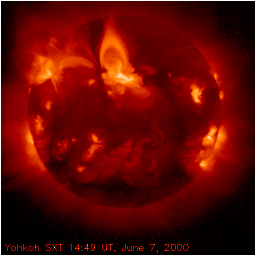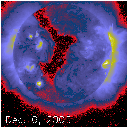
Table of Contents
Yohkoh SXT: Introduction
The Yohkoh Science Nuggets
The Authors
Chronological Listing
Topical Listing
We're Fascinated
Related Links

Weekly Science Notes from the Yohkoh Soft X-Ray Telescope
These weekly science notes are intended to give an unspecialized but scientifically fluent view of ongoing X-ray observations of the Sun from the Soft X-Ray Telescope (SXT) aboard the orbiting Yohkoh satellite. A nugget is a lump, esp. of native gold or other precious metal. These weekly science notes are nuggets, in the sense that they may have a rough exterior, but they have a precious substance beneath the surface.
Sometimes the authors of these nuggets -- the scientists who operate SXT -- get carried away with technical jargon. When that happens, use the glossary and/or the list of acronyms.
1997 Weekly Nuggets came into being in 1997, when it became obvious that a huge wealth of information was contained in the Yohkoh data base, and a continuing record of the highlights was needed. During this year it became clear that we had passed the minimum of the 11-year sunspot cycle sometime in 1996. The rise to solar maximum was underway!1998 The Nuggets in this year cover a diverse range of topics -- including flares and solar active regions (whose understanding is an important goal of Yohkoh), but also other phenomena related to the solar cycle, the effect of the Sun on Earth, and the "two steps forward, one step back" beginnings of the lurching return to a higher level of solar activity.1999 In this year, close collaboration with the ESA/NASA Solar and Heliospheric Observatory (SOHO) focussed attention on so-called halo coronal mass ejections (CMEs) as solar eruptions headed toward Earth. The solar activity level lagged behind expectations -- would it catch up? Would the peak really come in Y2K, as expected? Stay tuned!2000 Almost five years ago scientists predicted that the the maximum of solar cycle 23 will occur this year. As the year unfolds we will doubtless see many flares and coronal mass ejections, but we will have to wait until the end to see whether their prediction will be accurate. A big event was to have been the launch of NASA's HESSI solar flare mission, but a shakeup delayed it until 2001.2001 By any definition, it's the beginning of the millennium. Have we hit solar max yet? It's impossible to tell, until we're many months past it. Even the official prediction from the Space Environment Center at NOAA shows that we can't yet really be sure whether it's already happened or will happen during this year. We can only repeat our previous bit of advice -- stay tuned.
Weekly Science Notes from the Yohkoh SXT are not appropriate for citation in scientific publications




